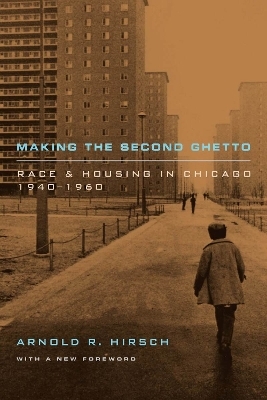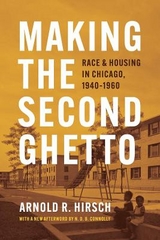
Making the Second Ghetto
Race and Housing in Chicago 1940-1960
Seiten
1998
University of Chicago Press (Verlag)
978-0-226-34244-3 (ISBN)
University of Chicago Press (Verlag)
978-0-226-34244-3 (ISBN)
- Titel erscheint in neuer Auflage
- Artikel merken
Zu diesem Artikel existiert eine Nachauflage
This text argues that, in the post-depression years, Chicago was a "pioneer in developing concepts and devices" for housing segregation and shows that the legal framework for the national urban renewal efforts was forged in the heat generated by the racial struggles waged on the city's South Side.
This text argues that in the post-depression years, Chicago was a "pioneer in developing concepts and devices" for housing segregation. The book shows that the legal framework for the national urban renewal efforts was forged in the heat generated by the racial struggles waged on Chicago's South Side. Its chronicle of the strategies used by ethnic, political and business interests in reaction to the great migration of southern blacks in the 1940s describes how the violent reaction of an emergent "white" population combined with public policy to segregate the city.
This text argues that in the post-depression years, Chicago was a "pioneer in developing concepts and devices" for housing segregation. The book shows that the legal framework for the national urban renewal efforts was forged in the heat generated by the racial struggles waged on Chicago's South Side. Its chronicle of the strategies used by ethnic, political and business interests in reaction to the great migration of southern blacks in the 1940s describes how the violent reaction of an emergent "white" population combined with public policy to segregate the city.
Arnold R. Hirsch (1949-2018) was the Ethel and Herman L. Midlo Endowed Chair for New Orleans Studies at the University of New Orleans.
List of tables and maps Foreword to the 1998 Edition Preface 1 The second ghetto and the dynamics of neighborhood 2 An era of hidden violence 3 Friends, neighbors, and rioters 4 The Loop versus the slums: downtown strikes back 5 A neighborhood on a hill: Hyde Park and the University of Chicago 6 Divided we stand: white unity and the color line at midcentury 7 Making the second ghetto Epilogue: Chicago and the nation Notes Index
| Erscheint lt. Verlag | 22.6.1998 |
|---|---|
| Reihe/Serie | Historical Studies of Urban America |
| Sprache | englisch |
| Maße | 15 x 24 mm |
| Gewicht | 595 g |
| Themenwelt | Geschichte ► Allgemeine Geschichte ► 1918 bis 1945 |
| Geschichte ► Allgemeine Geschichte ► Zeitgeschichte | |
| Geisteswissenschaften ► Geschichte ► Regional- / Ländergeschichte | |
| Sozialwissenschaften ► Ethnologie | |
| Sozialwissenschaften ► Pädagogik ► Sozialpädagogik | |
| Sozialwissenschaften ► Soziologie | |
| ISBN-10 | 0-226-34244-1 / 0226342441 |
| ISBN-13 | 978-0-226-34244-3 / 9780226342443 |
| Zustand | Neuware |
| Haben Sie eine Frage zum Produkt? |
Mehr entdecken
aus dem Bereich
aus dem Bereich
ein Psychologe erlebt das Konzentrationslager
Buch | Hardcover (2024)
Kösel (Verlag)
CHF 30,80
Mythos „Stauffenberg-Attentat“ – wie der 20. Juli 1944 verklärt und …
Buch | Hardcover (2024)
Goldmann (Verlag)
CHF 33,55



